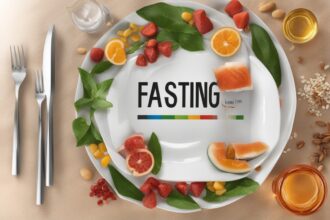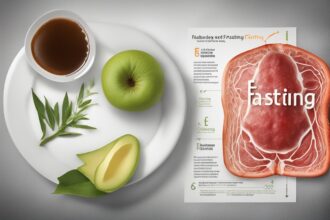Hey there, health enthusiasts! If you’ve been curious about health fasting and its impact on your body at a cellular level, you’re in for a treat. Today, we’re diving deep into the fascinating relationship between fasting and oxidative stress—a key player in aging and chronic disease. fasting isn’t just about skipping meals; it’s a powerful tool that can help your body combat harmful free radicals, enhance resilience, and potentially extend your lifespan. Whether you’re a seasoned faster or just starting to explore intermittent fasting benefits, this post will break down the science, offer practical tips, and show you how fasting for health can be a game-changer. Let’s unpack how fasting can protect your cells and why it’s worth considering as part of your wellness routine.
What Is Oxidative Stress, and Why Should You Care?
Before we connect the dots between health fasting and oxidative stress, let’s get clear on what oxidative stress actually is. In simple terms, it’s an imbalance in your body between free radicals—unstable molecules that can damage cells—and antioxidants, which neutralize them. When free radicals outnumber antioxidants, they can harm DNA, proteins, and lipids, contributing to aging, inflammation, and diseases like cancer, diabetes, and heart disease (Halliwell, 2007). Think of it like rust on metal; over time, this cellular “rust” wears down your body’s systems. So, why should you care? Because reducing oxidative stress is key to maintaining long-term health, and fasting might just be one of the most accessible ways to do it.
Every day, your body produces free radicals through normal processes like metabolism, but external factors like pollution, poor diet, and stress can ramp up their production. Antioxidants, whether from food or produced by your body, are your defense system. However, when this balance tips, oxidative damage creeps in. This is where fasting for health comes into play, as it can trigger protective mechanisms in your cells to fight back against this damage. Let’s explore how.
How Health Fasting Influences Oxidative Stress
Now, let’s talk about the magic of health fasting and how it interacts with oxidative stress. When you fast, your body shifts gears. Without a constant influx of food, it moves into a state of energy conservation and repair. Research shows that fasting—whether it’s intermittent fasting, time-restricted eating, or longer water fasts—can lower the production of free radicals and enhance your body’s antioxidant defenses (Longo & Mattson, 2014). This happens through a process called autophagy, where your cells clean out damaged components and recycle them for energy. Essentially, fasting gives your body a chance to “take out the trash” and reduce the oxidative burden.
Moreover, fasting triggers the activation of pathways like NRF2, which boosts the production of endogenous antioxidants such as glutathione—a powerhouse for detoxifying free radicals (Hayes & Dinkova-Kostova, 2014). Studies on animals and humans have shown that fasting can decrease markers of oxidative stress, like lipid peroxidation, while increasing antioxidant enzyme activity (Mattson et al., 2017). So, by incorporating fasting into your routine, you’re not just cutting calories; you’re giving your cells a fighting chance against damage. Pretty cool, right?
Types of Fasting for Health and Their Impact on Oxidative Stress
Not all fasting is created equal, and different approaches to health fasting can have varying effects on oxidative stress. Let’s break down a few popular methods and how they might help your body combat free radical damage. Whether you’re looking for fasting benefits for beginners or advanced protocols, there’s likely a style that fits your lifestyle.
- Intermittent Fasting (IF): This involves cycling between eating and fasting periods, like the 16/8 method (fast for 16 hours, eat during an 8-hour window). IF has been shown to reduce oxidative stress markers in overweight individuals by improving metabolic health (Harvie et al., 2011).
- Time-Restricted Eating (TRE): Similar to IF but focused on eating within a specific daily window, TRE helps align your body’s circadian rhythms, which can lower inflammation and oxidative damage.
- Prolonged Fasting: Lasting 48 hours or more, this type of fasting ramps up autophagy and antioxidant activity, though it should be done under supervision due to its intensity (Longo & Mattson, 2014).
- Alternate-Day Fasting (ADF): Alternating between normal eating days and very low-calorie days, ADF can decrease oxidative stress while improving insulin sensitivity.
Choosing the right fasting style depends on your goals, health status, and comfort level. The key takeaway? Even short fasting windows can kickstart protective processes in your body, making fasting for health a flexible and effective strategy.
Practical Tips to Maximize Fasting Benefits for Oxidative Stress Reduction
Ready to harness the power of health fasting to fight oxidative stress? It’s not just about skipping meals; how you approach fasting matters. Here are some actionable tips to ensure you’re getting the most out of your fasting journey while keeping your body in balance. I’ve learned these through my own experience and by digging into what experts recommend, so let’s make this practical.
- Start Slow: If you’re new to fasting for health, don’t jump into a 3-day water fast. Begin with a 12/12 schedule (12 hours fasting, 12 hours eating) and gradually increase the fasting window as your body adapts.
- Stay Hydrated: Dehydration can increase oxidative stress, so drink plenty of water during fasting periods. Herbal teas or black coffee (without sugar) are also great options.
- Focus on Nutrient-Dense Meals: When you break your fast, prioritize antioxidant-rich foods like berries, leafy greens, and nuts to support your body’s defenses.
- Avoid Overeating: Bingeing after a fast can spike blood sugar and inflammation, counteracting the benefits of fasting. Eat mindfully and stop when you’re satisfied.
- Listen to Your Body: Fasting shouldn’t leave you feeling drained or dizzy. If it does, scale back or consult a healthcare provider to ensure it’s safe for you.
By following these tips, you can ease into fasting and amplify its effects on reducing oxidative stress. Remember, consistency is more important than intensity—small, sustainable changes often yield the best results.
Potential Risks and Considerations of Health Fasting
While the benefits of health fasting for combating oxidative stress are impressive, it’s not a one-size-fits-all solution. Fasting can be incredibly beneficial, but it also comes with potential risks if not done thoughtfully. For some, especially those with medical conditions like diabetes or eating disorders, fasting can lead to issues like low blood sugar or nutrient deficiencies (Trepanowski & Bloomer, 2010). It’s also worth noting that prolonged fasting without proper preparation might temporarily increase oxidative stress before the body adapts, due to the stress of caloric restriction.
If you’re pregnant, breastfeeding, or on certain medications, fasting might not be suitable without medical guidance. Even for healthy individuals, overdoing it or fasting too frequently can lead to fatigue or hormonal imbalances. The takeaway here is simple: approach fasting for health with balance and awareness. Consult a doctor or dietitian if you’re unsure, and always prioritize how you feel over following a rigid plan. After all, the goal is to enhance your wellness, not stress your body out.
The Bigger Picture: Fasting, Oxidative Stress, and Longevity
Let’s zoom out for a moment and look at why the link between health fasting and oxidative stress matters in the grand scheme of things. Oxidative stress isn’t just a buzzword—it’s a major driver of aging and age-related diseases. By reducing this cellular damage through fasting, you’re potentially paving the way for a longer, healthier life. Studies suggest that caloric restriction and fasting mimicry can extend lifespan in animal models by slowing oxidative damage and improving metabolic efficiency (Fontana & Partridge, 2015). While human data is still emerging, early research on intermittent fasting shows promise for improving biomarkers of aging.
Beyond longevity, fasting for health can enhance brain function, reduce inflammation, and lower the risk of chronic conditions—all of which tie back to managing oxidative stress. It’s like giving your body a reset button, allowing it to focus on repair rather than constantly digesting food. So, whether you’re fasting to feel more energized or to protect your future health, you’re tapping into a practice with profound potential. How amazing is it that something as simple as timing your meals could have such a big impact?
As we wrap up, it’s clear that health fasting offers a promising way to tackle oxidative stress and support overall wellness. From boosting your body’s natural antioxidants to triggering cellular cleanup through autophagy, fasting does more than just cut calories—it transforms how your cells operate. By choosing a fasting style that suits you, starting slow, and pairing it with a nutrient-rich diet, you can harness these benefits safely and sustainably. Remember, though, that fasting isn’t a magic bullet; it’s a tool to be used wisely alongside other healthy habits. So, why not give it a try? Start with a short fast, see how you feel, and let your body guide you. Here’s to less oxidative stress and more vibrant health—cheers to fasting for a better tomorrow!
References
- Fontana, L., & Partridge, L. (2015). Promoting health and longevity through diet: From model organisms to humans. Cell, 161(1), 106–118. https://doi.org/10.1016/j.cell.2015.02.020
- Halliwell, B. (2007). Oxidative stress and cancer: Have we moved forward? Biochemical Journal, 401(1), 1–11. https://doi.org/10.1042/BJ20061131
- Harvie, M. N., Pegington, M., Mattson, M. P., et al. (2011). The effects of intermittent or continuous energy restriction on weight loss and metabolic disease risk markers: A randomized trial in young overweight women. International Journal of Obesity, 35(5), 714–727. https://doi.org/10.1038/ijo.2010.171
- Hayes, J. D., & Dinkova-Kostova, A. T. (2014). The Nrf2 regulatory network provides an interface between redox and intermediary metabolism. Trends in Biochemical Sciences, 39(4), 199–218. https://doi.org/10.1016/j.tibs.2014.02.002
- Longo, V. D., & Mattson, M. P. (2014). Fasting: Molecular mechanisms and clinical applications. Cell Metabolism, 19(2), 181–192. https://doi.org/10.1016/j.cmet.2013.12.008
- Mattson, M. P., Longo, V. D., & Harvie, M. (2017). Impact of intermittent fasting on health and disease processes. Ageing Research Reviews, 39, 46–58. https://doi.org/10.1016/j.arr.2016.10.005






